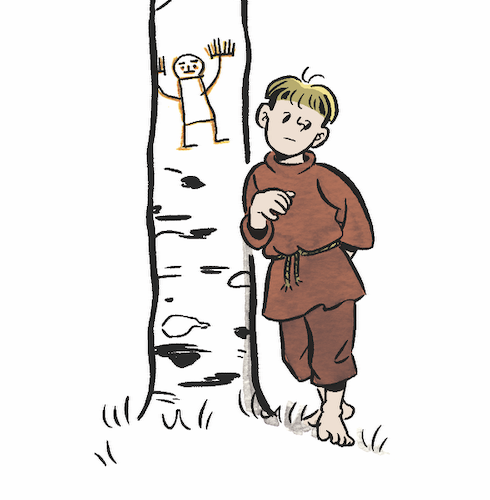
In the city of Novgorod, in the thirteenth century, a seven-year-old named Onfim drew mythical creatures on birchbark. Nothing about Onfim’s drawings are world-shattering. That is why I love them. He was a little boy, living in what is present-day Russia, who grew bored of his school assignments. His self-portraits look a bit like tadpoles or perhaps Mr. Potato Head, like the people I drew as a kid (and you probably did too): smiling ovals with sticks for limbs and a random smattering of fingers. It’s the same style of drawing you see affixed to fridges or drawn on the sidewalk in chalk. They are a developmental rite of passage and endearingly human.
One drawing features a catlike creature and the words “I am a wild beast” in the Cyrillic alphabet. Onfim also wrote “Greetings from Onfim to Daniel,” suggesting that he passed his masterpiece on to a friend. Another scrap of paper shows that Onfim abandoned his alphabet practice after just eleven letters, instead opting to draw a knightly figure on horseback, piercing an enemy on the ground. He plastered his name above it, appearing to label the heroic figure as himself. On another piece of paper, Onfim drew a stick figure boy fighting a bizarre multiheaded creature (kind of a Hydra): “Lord, help your servant Onfim,” he wrote, as if requesting divine intervention in his imaginary battle against the monster.
Onfim taps into some magical maternal instinct in me, and I could practically cry because I love him so much. Unlike the billions of kids whose drawings and daydreams have washed away into oblivion, Onfim’s seventeen preserved scraps of paper have given him a sort of eternal life. It’s possible that he became a grandfather or a scribe, or fulfilled his dream of being a famous warrior, but to us he’s forever a little boy who dreams of knightly valor while being stuck memorizing the Psalms. He captures something indescribable—his work feels like a rage comic, or a goofy Calvin and Hobbes saga. Onfim is the eternal boy, and one can only imagine how much he would have loved to drive a go-kart or play Minecraft.
Beginning in the ninth century, Onfim’s city of Novgorod became a bustling medieval trade hub. Its people appear to have had unusually high rates of literacy, and its wet low-oxygen soil (dubbed “archeological gold”) has given us many fossilized relics: more than one thousand birchbark documents filled with the unmediated voices of ordinary people have been discovered there since 1951. Around 1380, someone named Boris sent a note asking for someone named Nastasia to send him shirts he’d forgotten to pack on his journey. There are requests to buy barley, a reminder to hire a carpenter, a note in which a father tells his son the current price of salt. Sometime between 1280 and 1300, a man named Mikita proposed marriage to a woman named Anna, writing, “I want you, and you me.”
As long as there have been behaviorally modern humans—for at least the past forty thousand years, maybe longer—there have been imaginative little boys daydreaming about wild beasts. A few people wrote laws and dealt with the other boring affairs that tend to get classified as “history,” but the rest were falling in love or cooking dinner or doodling in the margins. There were probably knights who told corny dad jokes and medieval peasants who doubled over while laughing about some stupid inside joke. They weren’t brutish; they weren’t simple. Onfim’s drawings are a reminder of their intricate interiority.





